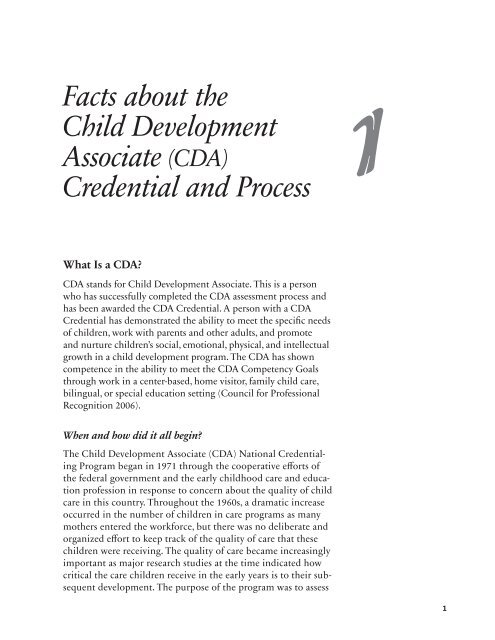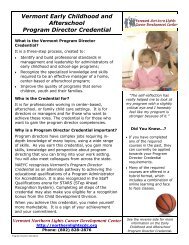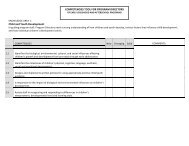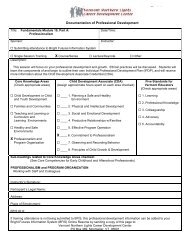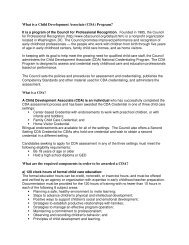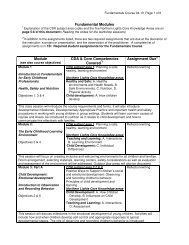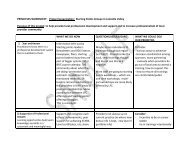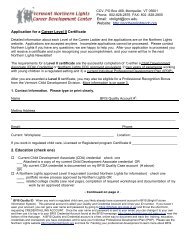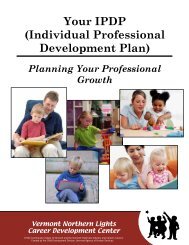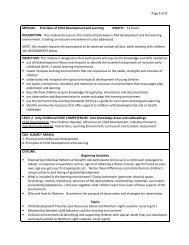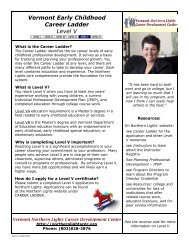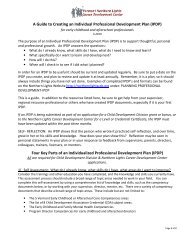Facts about the Child Development Associate (CDA) - Vermont ...
Facts about the Child Development Associate (CDA) - Vermont ...
Facts about the Child Development Associate (CDA) - Vermont ...
- No tags were found...
Create successful ePaper yourself
Turn your PDF publications into a flip-book with our unique Google optimized e-Paper software.
<strong>Facts</strong> <strong>about</strong> <strong>the</strong>1<strong>Child</strong> <strong>Development</strong><strong>Associate</strong> (<strong>CDA</strong>)Credential and ProcessWhat Is a <strong>CDA</strong>?<strong>CDA</strong> stands for <strong>Child</strong> <strong>Development</strong> <strong>Associate</strong>. This is a personwho has successfully completed <strong>the</strong> <strong>CDA</strong> assessment process andhas been awarded <strong>the</strong> <strong>CDA</strong> Credential. A person with a <strong>CDA</strong>Credential has demonstrated <strong>the</strong> ability to meet <strong>the</strong> specific needsof children, work with parents and o<strong>the</strong>r adults, and promoteand nurture children’s social, emotional, physical, and intellectualgrowth in a child development program. The <strong>CDA</strong> has showncompetence in <strong>the</strong> ability to meet <strong>the</strong> <strong>CDA</strong> Competency Goalsthrough work in a center-based, home visitor, family child care,bilingual, or special education setting (Council for ProfessionalRecognition 2006).When and how did it all begin?The <strong>Child</strong> <strong>Development</strong> <strong>Associate</strong> (<strong>CDA</strong>) National CredentialingProgram began in 1971 through <strong>the</strong> cooperative efforts of<strong>the</strong> federal government and <strong>the</strong> early childhood care and educationprofession in response to concern <strong>about</strong> <strong>the</strong> quality of childcare in this country. Throughout <strong>the</strong> 1960s, a dramatic increaseoccurred in <strong>the</strong> number of children in care programs as manymo<strong>the</strong>rs entered <strong>the</strong> workforce, but <strong>the</strong>re was no deliberate andorganized effort to keep track of <strong>the</strong> quality of care that <strong>the</strong>sechildren were receiving. The quality of care became increasinglyimportant as major research studies at <strong>the</strong> time indicated howcritical <strong>the</strong> care children receive in <strong>the</strong> early years is to <strong>the</strong>ir subsequentdevelopment. The purpose of <strong>the</strong> program was to assess
Why Is Getting a <strong>CDA</strong> Important?Working through <strong>the</strong> <strong>CDA</strong> process can be worthwhile and rewarding.In so doing, you can accomplish <strong>the</strong>se goals:• Earn a nationally recognized credential• Evaluate your own work as it compares with national standards,and improve on your skills• Receive one-on-one advice, support, and feedback fromearly childhood professionals who have knowledge of childdevelopment and experience working with young children• Improve upon your existing skills to <strong>the</strong> benefit of yourselfand <strong>the</strong> young children in your care(Council for Professional Recognition 2006)Who Can Apply for a <strong>CDA</strong>?Early childhood care and education workers who are in centerbasedchild care, family child care, or home visitor programs canbe evaluated by <strong>the</strong> Council. These workers need to have someeducation and experience in early child care and meet severalspecific requirements:• Be eighteen years of age or older.• Hold a high school diploma or GED.• Have 480 hours of experience working with young childrenwithin <strong>the</strong> past five years.• Have 120 clock hours of formal child care education within<strong>the</strong> past five years. It is important to note that <strong>the</strong> Councilwill consider waiving certain eligibility requirements if<strong>the</strong> candidate provides a written explanation, along withdocumentation that supports <strong>the</strong> request. Such requestsneed to be sent to <strong>the</strong> Council before you submit <strong>the</strong> <strong>CDA</strong>application. A Waiver Request form is provided in The <strong>CDA</strong>Assessment System and Competency Standards book in <strong>the</strong>application packet. The Council will notify <strong>the</strong> candidatewhe<strong>the</strong>r <strong>the</strong> waiver has been granted.(Council for Professional Recognition 2006)What Kind of Formal <strong>Child</strong> CareEducation Is Needed?The 120 clock hours of formal child care education must includeat least ten hours in each of <strong>the</strong> following subject areas:Chapter 1 <strong>Facts</strong> <strong>about</strong> <strong>the</strong> <strong>Child</strong> <strong>Development</strong> <strong>Associate</strong> (cda) Credential and Process
• Planning a safe, healthy environment, including safety,first aid, health, nutrition, space planning, materials andequipment• Steps to enhance children’s physical and intellectual development,for example, large- and small-muscle, language,discovery, art, and music activities• Positive ways to support children’s social and emotionaldevelopment through self-esteem, independence, selfcontrol,and socialization• Strategies to establish productive relationships with familiesthrough parent or guardian involvement, home visits,conferences, or referrals• Strategies to manage an effective program operation, includingplanning, record keeping, and reporting• Maintaining a commitment to professionalism, for example,through learning <strong>about</strong> advocacy, ethical practices, workforceissues, or professional associations• Observing and recording children’s behavior, learning tools,and strategies for objective information collection• Principles of child growth and development, for example,studying developmental milestones from birth through agefive or cultural influences on developmentThe training can be for college credit or for no credit. Formalcourses that cover <strong>the</strong> above topics might have titles such as <strong>the</strong>se:• <strong>Child</strong> Growth and <strong>Development</strong>• Health, Safety, and Nutrition in Early <strong>Child</strong>hood Programs• Guidance Techniques for Early <strong>Child</strong>hood• Introduction to <strong>the</strong> Early <strong>Child</strong>hood Profession• Emerging Literacy in Young <strong>Child</strong>ren• Early <strong>Child</strong>hood CurriculumYou may need to look at a college or agency catalog descriptionfor a specific course to see what topics it covers. These hours oftraining must be obtained from an organization or agency that hasexpertise in training early childhood teachers, including any of <strong>the</strong>se:• Four-year colleges and universities• Two-year junior and community colleges• Technical and vocational schools• Resource and referral agenciesThe <strong>CDA</strong> Prep Guide
• Early childhood education or child care programs that providetraining, such as family services, school districts, HeadStart, or employer-sponsored in-service training• Programs offered by <strong>the</strong> state or federal government or bybranches of <strong>the</strong> U.S. military servicesPlease note that training obtained at conferences or from individualconsultants is not accepted by <strong>the</strong> Council. A candidate mayacquire <strong>the</strong> 120 clock hours of training from one single trainingprogram or from a combination of programs. Most <strong>CDA</strong>s receive<strong>the</strong>ir training through credit courses or continuing educationunits (CEUs). On its Web site (www.cdacouncil.org), <strong>the</strong> Councilprovides a National Directory of Early <strong>Child</strong>hood PreparationInstitutions listed by state to which you can refer (Council forProfessional Recognition 2006).Is Financial Assistance Available to Help Payfor Your Training?Some state and local organizations offer financial assistancefor training, as well as for <strong>the</strong> <strong>CDA</strong> assessment fees. For example,some states participate in <strong>the</strong> Teacher Education andCompensation Helps (T.E.A.C.H.) Early <strong>Child</strong>hood Project.This program, which originated in North Carolina, providesscholarships for course work in early childhood education sochild care providers can work to increase <strong>the</strong>ir compensation.You can visit <strong>the</strong> <strong>Child</strong> Care Services Association Web site atwww.childcareservices.org/ps/teach.html to learn more <strong>about</strong> <strong>the</strong>T. E.A.C.H. program and to see a listing of participating states. Besure to inquire through your employer or local early childhoodprofessional association for more information <strong>about</strong> financialassistance. You may also be able to find free or low-cost trainingthrough your local resource and referral agency (Council forProfessional Recognition 2006).Do You Have to Provide Some Kind of ProofThat You Had This Training?Each agency or organization providing <strong>the</strong> training must provideproof of your education by means of a letter, certificate, or transcript.Break down <strong>the</strong> 120 hours into <strong>the</strong> required subject areason <strong>the</strong> Direct Assessment Application form. See appendix A onpage 179 for a listing of <strong>the</strong> <strong>CDA</strong> subject areas, along with examplesChapter 1 <strong>Facts</strong> <strong>about</strong> <strong>the</strong> <strong>Child</strong> <strong>Development</strong> <strong>Associate</strong> (cda) Credential and Process
of training or course topics that would be covered under each of<strong>the</strong>m (Council for Professional Recognition 2006).Are There Different Types of <strong>CDA</strong> Endorsements?GCenter-based programscan include nurseryschools, child care,Head Start, lab schools,child developmentprograms, or parentcooperatives. Theycan be full-time orpart-time operationsand have structured orunstructured schedules.These programscan be in universities,in public schools,churches, or privatelyowned and operated.Programs that meet <strong>the</strong><strong>CDA</strong> requirements fora center-based settingcan be nonprofit orfor-profit (Councilfor ProfessionalRecognition 2006).You may choose from several different <strong>CDA</strong> endorsements, each ina different setting:• Center-based infant/toddler• Center-based preschool• Family child care• Home visitor• Bilingual• Special educationThis choice depends on your specific experience with youngchildren in whichever of <strong>the</strong> categories you are currently workingand where you can be observed functioning as a lead teacher.Although you may not currently hold a lead teacher position atyour place of employment, during <strong>the</strong> advisor’s observation, youwill need to temporarily assume this role.You may not choose a setting in which you hope or intend towork in <strong>the</strong> future. For example, if you are working with infantsand toddlers in a center-based program, you may not apply for aCenter-Based Preschool Credential because you plan to move intoa classroom of older children in <strong>the</strong> near future. You must firstacquire a Center-Based Infant/Toddler Credential because this is<strong>the</strong> setting in which you currently work and where you will beobserved for your <strong>CDA</strong>. You may, at a later date, work toward aSecond Setting Credential for Center-Based Preschool once youhave accumulated 480 hours of experience with children in thatage group (Council for Professional Recognition 2006).What do <strong>the</strong>se settings look like?Center-based preschool setting This is a state-licensed child developmentcenter where a provider works with a group of at leasteight children. All of <strong>the</strong> children in <strong>the</strong> group are ages threethrough five years. Also, <strong>the</strong> entire center-based program needsto have at least ten children enrolled with at least two caregiversworking in <strong>the</strong> center with <strong>the</strong> children on a regular basis.Center-based infant/toddler setting This is a licensed child developmentcenter where a provider works as a primary caregiver witha group of at least three children ages birth through thirty-sixmonths. Also, <strong>the</strong> entire center-based program needs to have atThe <strong>CDA</strong> Prep Guide
least ten children enrolled with at least two caregivers working in<strong>the</strong> center with <strong>the</strong> children on a regular basis.Family child care setting This is a family child care home wherea provider works with at least two children, ages five years old oryounger. These children are not to be related to <strong>the</strong> candidate byei<strong>the</strong>r blood or marriage. This child care home must meet minimumstate and/or local regulations, unless it is located where <strong>the</strong>reis no regulation of family child care.Home visitor setting This is a program of home visits to familieswith young children ages birth through five years. Its main focusis providing support and education to parents, helping <strong>the</strong>m meet<strong>the</strong> needs of <strong>the</strong>ir growing children.Bilingual setting This is a child development center with specificgoals for supporting bilingual development in children. In this setting,two languages are consistently used and family involvementis encouraged to attain <strong>the</strong> program’s bilingual goals.GContact <strong>the</strong> Council(800–424–4310, www.cdacouncil.org) formore informationon home-visitorsetting, bilingualsetting, or specialeducation setting.GIn any of <strong>the</strong>se settings,a candidate may ei<strong>the</strong>rbe employed or workingas a volunteer.Special education setting This is a child development setting thatserves children with moderate to severe special needs. Settingcriteria will be <strong>the</strong> same as for center-based preschool, center-basedinfant/toddler, or family child care, based on <strong>the</strong> children’s agesand <strong>the</strong> type of program.The <strong>CDA</strong> ProcessThere are six stages in <strong>the</strong> <strong>CDA</strong> process. The first two stages—inquiry and documentation collection—need to be completedbefore you send in your application to <strong>the</strong> Council.1. InquiryDuring this stage, you check <strong>the</strong> eligibility requirements and makesure you meet <strong>the</strong>m and that you can be observed in an eligiblesetting. This first stage is also when you decide in which of <strong>the</strong> settings<strong>the</strong> assessment will take place (center-based preschool, centerbasedinfant/toddler, or family child care). This choice is based on<strong>the</strong> setting in which you can be observed in a lead teaching capacity.Remember that you need to choose <strong>the</strong> setting in which youhave your experience and in which you are currently working, nota setting in which you plan to work in <strong>the</strong> future.When <strong>the</strong> setting has been determined, you can send awayfor a packet of application materials. This can be done by contacting<strong>the</strong> Council for Professional Recognition at 800–424–4310Chapter 1 <strong>Facts</strong> <strong>about</strong> <strong>the</strong> <strong>Child</strong> <strong>Development</strong> <strong>Associate</strong> (cda) Credential and Process
or ordering online from its Web site at www.cdacouncil.org. Thecost of <strong>the</strong> application packet as of 2008 is $18, plus shipping andhandling. This price is subject to change, so check with <strong>the</strong> Councilprior to ordering. Tell <strong>the</strong>m which packet you want (center-basedpreschool, center-based infant/toddler, or family child care). Whenyou receive <strong>the</strong> application packet, it will contain <strong>the</strong> followingmaterials:• Two books outlining <strong>the</strong> Assessment System and <strong>the</strong>Competency Standards. (These books are different colors,depending on <strong>the</strong> specific setting. The book for family childcare is blue, <strong>the</strong> center-based preschool book is green, and<strong>the</strong> center-based infant/toddler book is yellow.)• A stack of Parent Opinion Questionnaires that you willdistribute and have returned to you in sealed envelopes• Direct Assessment Application form• <strong>CDA</strong> Assessment Observation InstrumentAs a <strong>CDA</strong> candidate, you will be assessed on <strong>the</strong> basis of <strong>the</strong>Council’s national standards. They are <strong>the</strong> criteria used to evaluatea caregiver’s performance with children and families. TheCompetency Standards are divided into six Competency Goals.Each is a general goal statement for caregiver behavior for any of<strong>the</strong> settings.The six Competency Goals are <strong>the</strong>n defined in greater detailby thirteen Functional Areas. These Functional Areas describemore specifically <strong>the</strong> functions a caregiver must perform to meet<strong>the</strong> criteria of each Competency Goal and will vary according to acandidate’s particular child care setting and/or <strong>the</strong> age groupingsof <strong>the</strong> children.These are <strong>the</strong> six Competency Goals:Competency Goal I: To establish and maintain a safe,healthy, learning environment.Competency Goal II: To advance physical andintellectual competence.Competency Goal III: To support social and emotionaldevelopment and to provide positive guidance.Competency Goal IV: To establish positive andproductive relationships with families.Competency Goal V: To ensure a well-run, purposefulprogram responsive to participant needs.Competency Goal VI: To maintain a commitmentto professionalism.(Council for Professional Recognition 2006).The <strong>CDA</strong> Prep Guide
2. Collection of documentationDuring this stage of <strong>the</strong> process, you begin to assemble yourProfessional Resource File, which includes a collection of resourcematerials, an autobiography, and written examples of your competencerelating to each of <strong>the</strong> six <strong>CDA</strong> Competency Goals. Youwill also distribute and collect Parent Opinion Questionnaires todetermine <strong>the</strong> parents’ opinions of your work with young children(Council for Professional Recognition 2006).Also during this second stage, you connect with an advisor.The advisor is <strong>the</strong> person who comes to observe you at work andwho completes <strong>the</strong> <strong>CDA</strong> Assessment Observation Instrument.Often, when a candidate obtains required training throughan early childhood education program at a college, university, ortraining agency, an instructor will also serve as <strong>the</strong> <strong>CDA</strong> advisor.If, however, you are not in such a program, it will be up to you tolocate a <strong>CDA</strong> advisor.You may locate an advisor of your choosing who meets <strong>the</strong>required criteria, or <strong>the</strong> Council will provide, upon request, a listingof registered advisors in your particular state. The <strong>CDA</strong> advisorhas to be qualified in <strong>the</strong>se ways:• Able to relate to people of various ethnic, racial, and socioeconomicbackgrounds• Knowledgeable <strong>about</strong> national, state, and local requirementsand standards for child care programs serving children frombirth through five years old• Familiar with <strong>the</strong> center where you will be observed (or ifyou are working in family child care, familiar with familychild care) and <strong>the</strong> needs of <strong>the</strong> families and children in <strong>the</strong>communityAdditional RequirementsThere are additional requirements for <strong>the</strong> advisor, depending onwhich type of <strong>CDA</strong> you are earning. The advisor needs to meet <strong>the</strong>requirements listed in your <strong>CDA</strong> Assessment System and CompetencyStandards book in appendix C, Advisor Eligibility Requirements:Center-Based PreschoolOption 1• A bachelor of arts, bachelor of science, or advanced degree inearly childhood education/child development or home economics/child development from an accredited college or university. TheChapter 1 <strong>Facts</strong> <strong>about</strong> <strong>the</strong> <strong>Child</strong> <strong>Development</strong> <strong>Associate</strong> (cda) Credential and Process
degree must have included twelve semester hours covering <strong>the</strong>education of children from birth through five years old.• Two years of experience in a child care setting, serving childrenfrom birth through five years old. One year of that time needsto have been spent working directly with children as a caregiver,teacher, child life worker, or social worker, or in a similar role.• The prospective advisor also needs to have been responsible for<strong>the</strong> professional growth of ano<strong>the</strong>r adult for one year.Option 2• An associate’s or two-year degree in early childhood education/child development, home economics/child development from anaccredited college or university. The degree must have includedtwelve semester hours covering <strong>the</strong> education of children frombirth through five years old.• Four years of experience in a child care setting in a program servingchildren from birth through five years old. Two years of that timeneeds to have been spent working directly with children as a caregiver,teacher, child life worker, or social worker, or in a similar role.• The prospective advisor also needs to have been responsible for<strong>the</strong> professional growth of ano<strong>the</strong>r adult for two years.Option 3• An active <strong>CDA</strong> Credential.• Twelve semester hours of study in early childhood education orchild development at an accredited college or university, coveringchildren from birth through five years old.• Six years of experience in a child care setting in a program servingchildren from birth through five years old. Four years of that timeneeds to have been spent working directly with children as a caregiver,teacher, child life worker, or social worker, or in a similar role.• The prospective advisor also needs to have been responsible for<strong>the</strong> professional growth of ano<strong>the</strong>r adult for two years.Center-Based Infant/ToddlerOption 1• A bachelor of arts, bachelor of science, or advanced degree in earlychildhood education/child development or in home economics/child development from an accredited college or university. Thedegree must have included twelve semester hours coveringchildren from birth through five years old.• Two years of experience in a child care setting serving childrenfrom birth through three years old. One year of that time needsto have been spent working directly with children as a caregiver,teacher, child life worker, or social worker, or in a similar role.10 The <strong>CDA</strong> Prep Guide
• One year of responsibility for <strong>the</strong> professional growth ofano<strong>the</strong>r adult.Option 2• An associate’s or two-year degree in early childhood education/child development or home economics/child development froman accredited college or university. The degree must have includedtwelve semester hours covering children from birth through fiveyears old.• Four years of experience in a child care setting serving childrenfrom birth through three years old. Two years of that time needsto have been spent working directly with children as a caregiver,teacher, child life worker, or social worker, or in a similar role.• Two years of responsibility for <strong>the</strong> professional growth ofano<strong>the</strong>r adult.Option 3• An active <strong>CDA</strong> Credential.• Twelve semester hours of study in early childhood education orchild development at an accredited college or university coveringchildren from birth through five years old.• Six years of experience in a child care setting in a program servingchildren from birth through three years old, including experienceworking directly with children as a caregiver, teacher, or child lifeworker, or in a similar role.• Two years of responsibility for <strong>the</strong> professional growth ofano<strong>the</strong>r adult.Family <strong>Child</strong> CareOption 1• A bachelor of arts, bachelor of science, or advanced degree in earlychildhood education/child development or in home economics /child development from an accredited college or university. Thedegree must have included twelve semester hours coveringchildren from birth through five years old, with two courses oninfant /toddler development.• Two years of experience in a child care setting serving childrenfrom birth through five years old. One year of that time needs tohave been spent working directly with children in <strong>the</strong> same agerange as <strong>the</strong> children in your home, as a caregiver, teacher, childlife worker, or social worker, or in a similar role.• The prospective advisor also needs to have been responsible for<strong>the</strong> professional growth of ano<strong>the</strong>r adult for one year or have helda leadership position in a child care organization.Chapter 1 <strong>Facts</strong> <strong>about</strong> <strong>the</strong> <strong>Child</strong> <strong>Development</strong> <strong>Associate</strong> (cda) Credential and Process11
• Experience in a family child care setting as a provider, trainer,or parent.Option 2• An associate’s or two-year degree in early childhood education/child development or home economics/child developmentfrom an accredited college or university. The degree must haveincluded twelve semester hours covering children from birththrough five years old, with two courses on infant/toddlerdevelopment.• Four years of experience in a child care setting in a programserving children from birth through five years old, includingexperience working directly with children in <strong>the</strong> same age rangeas <strong>the</strong> children in your home, as a caregiver, teacher, child lifeworker, or social worker, or in a similar role.• The prospective advisor also needs to have been responsible for<strong>the</strong> professional growth of ano<strong>the</strong>r adult or have held a leadershipposition in a child care organization.Option 3• An active <strong>CDA</strong> Credential.• Twelve semester hours of study in early childhood education orchild development at an accredited college or university coveringchildren from birth through five years old.• Six years of experience in a child care setting in a program servingchildren from birth through five years old, including experienceworking directly with children in <strong>the</strong> same age range as <strong>the</strong>children in your home, as a caregiver, teacher, child life worker, orsocial worker, or in a similar role.• The prospective advisor also needs to have been responsible for<strong>the</strong> professional growth of ano<strong>the</strong>r adult or have held a leadershipposition in a child care organization.Keep in mind that your choice of an advisor could present aconflict of interest. For <strong>the</strong> advisor to conduct an objective andcredible assessment observation, you need to choose someone whomeets certain additional requirements:• The advisor must not be working as a co-teacher with youon a daily basis with <strong>the</strong> same group of children.• The advisor must not be a relative of a child in your care atany time during <strong>the</strong> assessment process.• The advisor must not be related by blood or marriage oro<strong>the</strong>r legal relationship to you.12 The <strong>CDA</strong> Prep Guide
Having a good <strong>CDA</strong> advisor is important. If at all possible,locate an advisor who will agree to spend some time with youduring <strong>the</strong> <strong>CDA</strong> process, ra<strong>the</strong>r than merely conducting <strong>the</strong> finalassessment observation. Ideally, <strong>the</strong> advisor you choose will beyour mentor. She will be <strong>the</strong>re to answer your questions, look overyour Professional Resource File, proofread your Competency GoalStatements and autobiography, give you valuable tips, help prepareyour setting so it meets Council standards, and intercede for you, ifnecessary.Your advisor is <strong>the</strong> person in your corner, your cheerleaderthroughout this process. She should take <strong>the</strong> job seriously andconsider your success in getting a <strong>CDA</strong> Credential her responsibilityand a direct reflection on herself. If you feel your advisor isanything less, look for ano<strong>the</strong>r!3. ApplicationIf you work in a center, you, your advisor, and your center directorwill fill out <strong>the</strong> Direct Assessment Application form. This applicationform will be sent to <strong>the</strong> Council, along with documentation of<strong>the</strong> 120 hours of training, and <strong>the</strong> application fee, which is $325 asof 2008. This fee may change so be sure to check in your applicationpacket for any updates (Council for Professional Recognition 2006).After you send in your application to <strong>the</strong> Council, three stagesin <strong>the</strong> <strong>CDA</strong> process remain to be completed:4. Verification visit by <strong>the</strong> Council representativeAfter <strong>the</strong> Council receives <strong>the</strong> completed application form andverifies your eligibility, it will assign a specially trained early childhoodprofessional to meet with you. This Council representativewill call to set up an appointment for a verification visit.The meeting place can be decided between you and <strong>the</strong>Council representative. If you are in a center-based program, <strong>the</strong>verification visit can be, but does not have to be, conducted inyour place of employment. A quiet place is preferable, such as apublic library or somewhere on a college campus where a privateroom with a door and adult chairs and tables is available. If youare a family child care provider, <strong>the</strong> verification visit may not beconducted in your home or in any o<strong>the</strong>r private home.During this meeting, <strong>the</strong> Council representative will give youa written, sixty-question, multiple-choice exam called <strong>the</strong> Early<strong>Child</strong>hood Studies Review. This test measures your knowledge ofgood practices in early childhood education. Your performance onGYou will need to haveyour ProfessionalResource Filecompleted before<strong>the</strong> Councilrepresentative’s visit.Chapter 1 <strong>Facts</strong> <strong>about</strong> <strong>the</strong> <strong>Child</strong> <strong>Development</strong> <strong>Associate</strong> (cda) Credential and Process13
this exam is only one part of <strong>the</strong> documentation that <strong>the</strong> Councilconsiders in its decision to award <strong>the</strong> <strong>CDA</strong> Credential. You willnot receive your grade for this exam.The Council representative will also give you an oral interview.During this interview, you should demonstrate your expertisein several early childhood situations. Additionally, <strong>the</strong> representativewill check your Professional Resource File to see whe<strong>the</strong>r it isaccurate and complete.At <strong>the</strong> conclusion of <strong>the</strong> visit, <strong>the</strong> representative will collectseveral things from you:• The <strong>CDA</strong> Assessment Observation Instrument booklet thatyour advisor completed, which must be in a sealed envelope• The completed Parent Opinion Questionnaires, also in asealed envelope• Copies of your Competency Goals and Statements (<strong>the</strong> sixessays)• A copy of your autobiographyThe documentation items must be prepared/collected/compiled within six months of submitting <strong>the</strong> application form.All of <strong>the</strong>se items, along with your answer sheet from <strong>the</strong> Early<strong>Child</strong>hood Studies Review and <strong>the</strong> results of <strong>the</strong> oral interview,will be sent by <strong>the</strong> Council representative to <strong>the</strong> Council inWashington, DC, where <strong>the</strong>y will be evaluated.The Council schedules verification visits four times a year.Before preparing <strong>the</strong> documentation items as listed above, youshould decide in which quarter you want to have a verificationvisit scheduled and <strong>the</strong>n be sure to submit <strong>the</strong> application form by<strong>the</strong> deadline for that quarter.Application DeadlineDecember 1March 1June 1September 1Time of Verification Visit1st quarterJanuary, February, March2nd quarterApril, May, June3rd quarterJuly, August, September4th quarterOctober, November, DecemberA possible alternative to <strong>the</strong> traditional verification visit is <strong>the</strong>online assessment option. Online assessment is not a replacementfor <strong>the</strong> <strong>CDA</strong> process. You need to produce <strong>the</strong> same, required14 The <strong>CDA</strong> Prep Guide
documentation (Professional Resource File, Competency GoalStatements, and completed Parent Opinion Questionnaires) andwill still be observed by a <strong>CDA</strong> advisor. The difference is <strong>the</strong>option of submitting a preliminary registration and applicationonline and <strong>the</strong>n completing <strong>the</strong> Early <strong>Child</strong>hood Studies Reviewexam and <strong>the</strong> oral interview online. The <strong>CDA</strong> advisor and yourdirector (if you are in a center-based program) will be asked foronline input, which can cause delays, depending on how prompt<strong>the</strong>se persons are in responding to <strong>the</strong> e-mail prompts providedby <strong>the</strong> Council. Also, <strong>the</strong> required documentation (ProfessionalResource File, Competency Goal Statements, and Parent OpinionQuestionnaires) will still need to be reviewed and evaluated by aCouncil representative. Therefore, <strong>the</strong> actual time savings offeredby <strong>the</strong> online assessment option could be minimal.There are additional considerations to think <strong>about</strong> beforechoosing <strong>the</strong> online assessment option. Completing <strong>the</strong> Early<strong>Child</strong>hood Studies Review exam online is fine if you work wellalone. If not, you may benefit from having a Council representative<strong>the</strong>re in person, in case you need some clarification. During<strong>the</strong> oral interview, if you are not responding correctly to a particularscenario, <strong>the</strong> Council representative can provide prompts tohelp you. You are on your own if this assessment is done online.The online assessment has no application deadlines to meetand can give you more flexibility and control over <strong>the</strong> process, insome respects. The quarterly deadlines (see page 14) for <strong>the</strong> traditionalmethod are actually beneficial to many candidates, helping<strong>the</strong>m stay on task and motivated toward completion. This isimportant, since some of <strong>the</strong> candidate’s documentation and <strong>the</strong><strong>CDA</strong> Assessment Observation Instrument that <strong>the</strong> advisor completesexpire after six months. Having a set time frame in whichto complete <strong>the</strong> <strong>CDA</strong> process is a real plus for those who tend toprocrastinate.5. Credential awardA Council committee looks over <strong>the</strong> materials sent to <strong>the</strong>m by <strong>the</strong>Council representative. Because quite a few components compose<strong>the</strong> <strong>CDA</strong> assessment—including <strong>the</strong> acquired training, Early<strong>Child</strong>hood Studies Review exam, assessment observation, oral interview,Professional Resource File, Competency Goal Statements,and o<strong>the</strong>r items—<strong>the</strong> committee’s decision is not based on onlyone component but on all of <strong>the</strong>se components taken as a whole.If everything meets with <strong>the</strong> Council’s approval, <strong>the</strong> credential isawarded and is sent to <strong>the</strong> new <strong>CDA</strong>.Chapter 1 <strong>Facts</strong> <strong>about</strong> <strong>the</strong> <strong>Child</strong> <strong>Development</strong> <strong>Associate</strong> (cda) Credential and Process15
If <strong>the</strong> Council committee determines, for one reason or ano<strong>the</strong>r,that you do not qualify for a credential, you will be notifiedand informed of appeal procedures and o<strong>the</strong>r options of what todo next. All information <strong>about</strong> <strong>CDA</strong> candidates is confidential. TheCouncil will not release assessment information to anyone withoutyour permission (Council for Professional Recognition 2006).6. Credential renewalA <strong>CDA</strong> Credential is valid for three years. After that, you mayrenew it for five-year periods. To do that you will need to order arenewal packet. This can be ordered from <strong>the</strong> Council for $13, plusshipping and handling. This price may be subject to change, soplease check with <strong>the</strong> Council prior to ordering. A <strong>CDA</strong> may renewher credential only for <strong>the</strong> original setting, age-level endorsement,and specialization (Council for Professional Recognition 2006).The following chapters include step-by-step instructionsfor assembling your Professional Resource File and writing <strong>the</strong>Competency Goal Statements. You will learn how to prepare for<strong>the</strong> assessment observation by your <strong>CDA</strong> advisor and <strong>the</strong> verificationvisit with <strong>the</strong> <strong>CDA</strong> representative. You will find <strong>the</strong> help youneed, specific to your particular age-level endorsement and setting,in chapter 3 for center-based preschool, chapter 4 for center-basedinfant/toddler, or chapter 5 for family child care.16 The <strong>CDA</strong> Prep Guide


